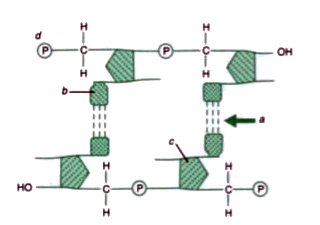The two strands/two polynucleotide chains of DNA are
similar I nature and antiparallel
discontinuous in nature
antiparallel and complementary
parallel and discontinuous
The correct Answer is:C
To answer the question regarding the nature of the two strands or two polynucleotide chains of DNA, we can break down the solution into the following steps:
1. Understanding DNA Structure:
- DNA is composed of two strands that form a double helix. Each strand is a polynucleotide chain made up of nucleotides.
2. Base Pairing:
- The two strands are held together by complementary base pairing. This means that specific bases pair with each other: adenine (A) pairs with thymine (T), and guanine (G) pairs with cytosine (C).
3. Directionality of Strands:
- The strands of DNA have directionality. One strand runs in the 3' to 5' direction, while the other runs in the 5' to 3' direction. This opposite orientation is referred to as being "anti-parallel."
4. Nature of the Strands:
- The two strands are not similar in nature; they are complementary. This means that the sequence of bases on one strand determines the sequence of bases on the other strand.
5. Evaluating the Options:
- Option A: Similar in nature and anti-parallel - Incorrect, as the strands are not similar.
- Option B: Discontinuous in nature - Incorrect, as the strands are continuous.
- Option C: Anti-parallel and complementary - Correct, as the strands are indeed anti-parallel and complementary.
- Option D: Parallel and discontinuous - Incorrect, as the strands are anti-parallel and continuous.
6. Conclusion:
- The correct answer is Option C: The two strands or two polynucleotide chains of DNA are anti-parallel and complementary.
- DNA is composed of two strands that form a double helix. Each strand is a polynucleotide chain made up of nucleotides.
- The two strands are held together by complementary base pairing. This means that specific bases pair with each other: adenine (A) pairs with thymine (T), and guanine (G) pairs with cytosine (C).
- The strands of DNA have directionality. One strand runs in the 3' to 5' direction, while the other runs in the 5' to 3' direction. This opposite orientation is referred to as being "anti-parallel."
- The two strands are not similar in nature; they are complementary. This means that the sequence of bases on one strand determines the sequence of bases on the other strand.
- Option A: Similar in nature and anti-parallel - Incorrect, as the strands are not similar.
- Option B: Discontinuous in nature - Incorrect, as the strands are continuous.
- Option C: Anti-parallel and complementary - Correct, as the strands are indeed anti-parallel and complementary.
- Option D: Parallel and discontinuous - Incorrect, as the strands are anti-parallel and continuous.
- The correct answer is Option C: The two strands or two polynucleotide chains of DNA are anti-parallel and complementary.
Topper's Solved these Questions
Similar Questions
Knowledge Check
At 5’ end of a polynucleotide chain
A-OH group is attachedBPhosphate group is attachedCPentose sugar is attachedDH-bond is presentThe two strands of double helix of DNA are linked together by hydrogen bonds between :
AbasesBdeoxysugarsCphosphatesDribose sugars
Read the following statements-
(A)- The base pairing confers a very unique property to the polynucleotide chains of DNA i.e complementarity,(B)- Each strand from a DNA acts as a template for synthesis of a new strand.
View SolutionSelect the wrong statements with respect to DNA .
(i) The backbone of DNA is formed by the sugar-phosphate chain.
(ii) The two strands of the Polynucleotide are anti-parallel.
(iii) The nitrogen bases are parallel to the backbone .
(iv) The backbone contains a hydrogen bond.
View SolutionIn the polynucleotide chain of DNA, a nitrogenous base is linked to the -OH of:
View SolutionStudy the given portion of double stranded polynucleotide chain carefully. Identify a,b , c , and the 3' and 5' end of the chain
View SolutionStudy the given portion of double-stranded polynucleotide chain carefully. Identify a, b, c and d.

View SolutionThe nucleases Cleaving nucleotides one at a time from the end of the Polynucleotide chain are :
View Solution
